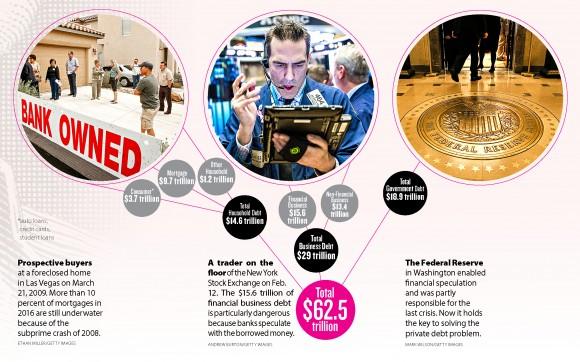The world is drowning in debt—$152 trillion, or 225 percent of the world’s GDP, according to the International Monetary Fund. In the United States, total debt (including government and private) exceeds $62.5 trillion, or 334 percent of GDP, according to current Federal Reserve data—that’s $196,000 for every man, woman, and child in this country.
Debt itself isn’t a problem, if it’s spent and invested wisely. But rising debt-to-GDP ratios mean the debt hasn’t led to increases in output, so it cannot be paid down. If debt is not productive, it constrains economic activity, which is one of the reasons the recovery since the Great Recession has been the weakest on record.
Historically, debt levels of this magnitude have never been paid back in real terms. They were reduced through default or inflation, with sometimes devastating results. This time around, however, creative economists say there are ways to reduce the debt burden without disrupting the economy too much.
The Problem: Private Debt
“Demand has fallen because of the high level of private debt we have. People don’t want to take out debt; banks aren’t willing to lend. This means no creation of new debt money and a lack of turnover of existing money,” said Steve Keen, a professor at Kingston University in London and author of “Debunking Economics.”
He said the creation of new debt is one of the major sources of demand and is mostly responsible for the period of almost uninterrupted economic growth from 1980 to 2008.
But private households and businesses—let’s leave the government for later—cannot take on infinite amounts of debt because they have to generate the cash flow to pay interest. And they actually have to pay back.
From the borrower’s perspective, there is a limit to how much money he wants to use for interest payments. Most people also don’t want their credit scores impaired or want to go bankrupt, putting another limit on private household debt.
“The issue is, if businesses and individuals are overleveraged, they are reluctant to increase borrowing, and we know that increases in borrowing increase economic growth,” said Richard Vague, managing partner at Gabriel Investments and author of “The Next Economic Disaster.”
In fact, households are still struggling with the housing debacle of 2008. As of the first quarter of 2016, 12.7 percent of homeowners owed more than their house was worth, according to the research firm Zillow. Mortgages make up $9.7 trillion of the $14.6 trillion in household debt as of the third quarter of 2016.






